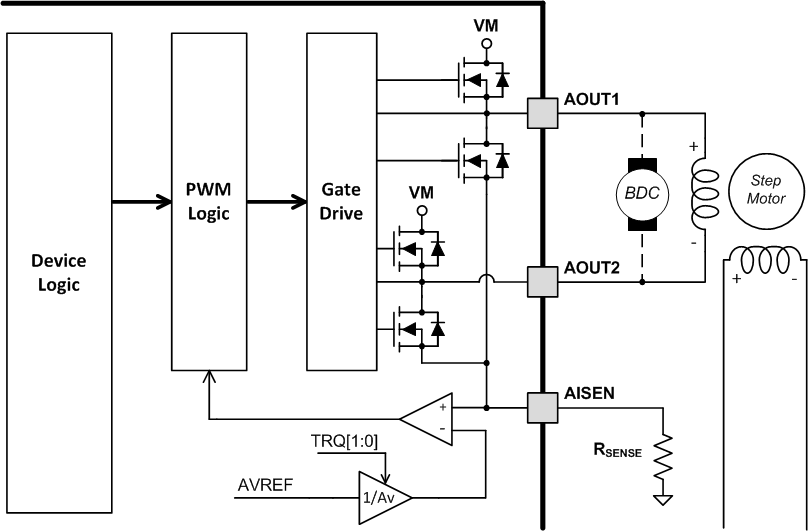SLVSD19A June 2015 – July 2015 DRV8881
PRODUCTION DATA.
- 1 Features
- 2 Applications
- 3 Description
- 4 Revision History
- 5 Pin Configuration and Functions
- 6 Specifications
-
7 Detailed Description
- 7.1 Overview
- 7.2 Functional Block Diagrams
- 7.3
Feature Description
- 7.3.1 Motor Driver Current Ratings
- 7.3.2 PWM Motor Drivers
- 7.3.3 Bridge Control
- 7.3.4 Current Regulation
- 7.3.5 Decay Modes
- 7.3.6 Smart tune
- 7.3.7 Adaptive Blanking Time
- 7.3.8 Parallel Mode
- 7.3.9 Charge Pump
- 7.3.10 LDO Voltage Regulator
- 7.3.11 Logic and Tri-Level Pin Diagrams
- 7.3.12 Protection Circuits
- 7.4 Device Functional Modes
- 8 Application and Implementation
- 9 Power Supply Recommendations
- 10Layout
- 11Device and Documentation Support
- 12Mechanical, Packaging, and Orderable Information
Package Options
Mechanical Data (Package|Pins)
Thermal pad, mechanical data (Package|Pins)
Orderable Information
7.3.4 Current Regulation
The current through the motor windings is regulated by an adjustable fixed-off-time PWM current regulation circuit. When an H-bridge is enabled, current rises through the winding at a rate dependent on the DC voltage, inductance of the winding, and the magnitude of the back EMF present. Once the current hits the current chopping threshold, the bridge enters a decay mode for a fixed period of time to decrease the current, which is configurable between 10 and 30 µs through the tri-level input TOFF. After the off time expires, the bridge is re-enabled, starting another PWM cycle.
Table 3. Off-Time Settings
| TOFF | OFF-TIME tOFF |
|---|---|
| 0 | 20 µs |
| 1 | 30 µs |
| Z | 10 µs |
The PWM chopping current is set by a comparator which compares the voltage across a current sense resistor connected to the xISEN pin with a reference voltage. To generate the reference voltage for the current chopping comparator, the xVREF input is attenuated by a factor of Av. In addition, the TRQx pins further scale the reference.
 Figure 15. Current Regulation Block Diagram
Figure 15. Current Regulation Block Diagram The chopping current is calculated as follows:

TRQ is a DAC used to scale the output current. The current scalar value for different inputs is shown in Table 4.
Table 4. Torque DAC Settings
| TRQ1 | TRQ0 | CURRENT SCALAR (TRQ) | EFFECTIVE ATTENUATION |
|---|---|---|---|
| 1 | 1 | 25% | 26.4 V/V |
| 1 | 0 | 50% | 13.2 V/V |
| 0 | 1 | 75% | 8.8 V/V |
| 0 | 0 | 100% | 6.6 V/V |